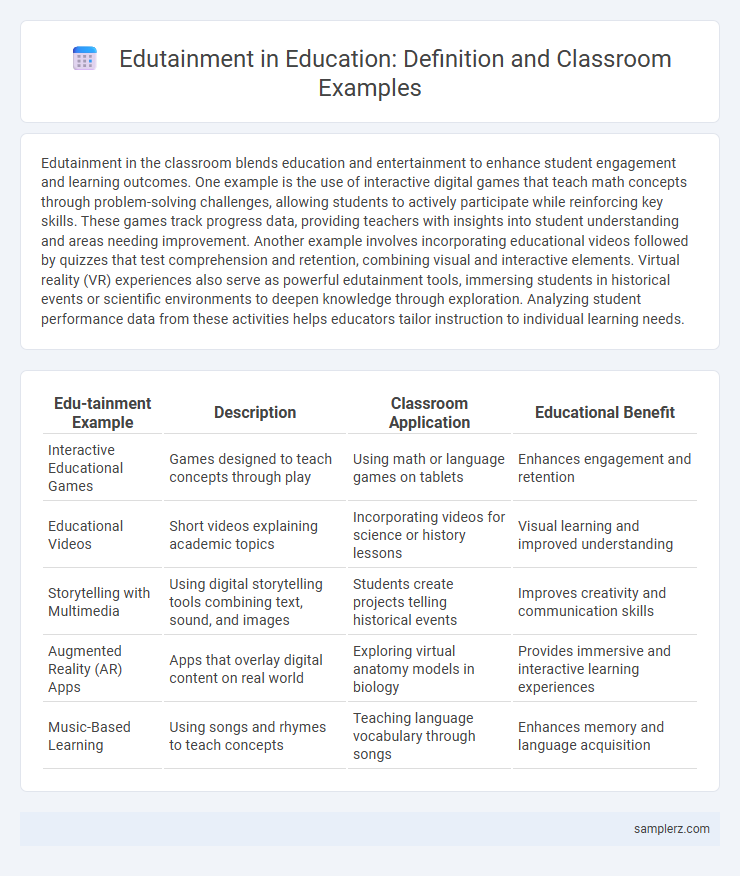Edutainment in the classroom blends education and entertainment to enhance student engagement and learning outcomes. One example is the use of interactive digital games that teach math concepts through problem-solving challenges, allowing students to actively participate while reinforcing key skills. These games track progress data, providing teachers with insights into student understanding and areas needing improvement. Another example involves incorporating educational videos followed by quizzes that test comprehension and retention, combining visual and interactive elements. Virtual reality (VR) experiences also serve as powerful edutainment tools, immersing students in historical events or scientific environments to deepen knowledge through exploration. Analyzing student performance data from these activities helps educators tailor instruction to individual learning needs.
Table of Comparison
| Edu-tainment Example | Description | Classroom Application | Educational Benefit |
|---|---|---|---|
| Interactive Educational Games | Games designed to teach concepts through play | Using math or language games on tablets | Enhances engagement and retention |
| Educational Videos | Short videos explaining academic topics | Incorporating videos for science or history lessons | Visual learning and improved understanding |
| Storytelling with Multimedia | Using digital storytelling tools combining text, sound, and images | Students create projects telling historical events | Improves creativity and communication skills |
| Augmented Reality (AR) Apps | Apps that overlay digital content on real world | Exploring virtual anatomy models in biology | Provides immersive and interactive learning experiences |
| Music-Based Learning | Using songs and rhymes to teach concepts | Teaching language vocabulary through songs | Enhances memory and language acquisition |
Integrating Games for Interactive Learning
Integrating games like Kahoot and Quizizz in the classroom enhances interactive learning by promoting student engagement and immediate feedback. These platforms utilize gamified quizzes that reinforce subject concepts while fostering healthy competition and collaboration among peers. Incorporating educational games supports differentiated instruction by catering to diverse learning styles and encouraging critical thinking skills.
Storytelling Techniques to Teach Complex Concepts
Storytelling techniques in classrooms transform complex concepts such as scientific theories or historical events into engaging narratives, enhancing student comprehension and retention. Using character-driven plots and vivid scenarios helps students connect emotionally and intellectually with the material. This method leverages cognitive psychology principles, making abstract ideas more accessible and memorable through relatable storytelling.
Educational Videos and Animation as Teaching Tools
Educational videos and animations serve as powerful edutainment tools in classrooms, enhancing student engagement by visually demonstrating complex concepts like scientific processes and historical events. These multimedia resources facilitate better retention and understanding through dynamic storytelling and interactive elements that cater to diverse learning styles. Studies show that integrating animation and video content can improve learning outcomes by up to 30%, making them essential in modern pedagogical strategies.
Role-Playing Activities to Enhance Student Engagement
Role-playing activities in the classroom transform traditional lessons into immersive learning experiences by allowing students to embody historical figures, literary characters, or scientific concepts, fostering deeper understanding and empathy. This interactive method promotes critical thinking, communication skills, and collaborative problem-solving, which are key competencies in 21st-century education. Studies show that classrooms incorporating role-play see increased student motivation and higher retention rates, making it a powerful edutainment strategy to enhance overall engagement.
Gamified Assessments for Motivation and Retention
Gamified assessments in the classroom enhance student motivation and retention by integrating game mechanics such as points, badges, and leaderboards into quizzes and tests. These interactive evaluations promote active learning, increase engagement, and provide immediate feedback, leading to improved knowledge retention. Studies show that gamified assessments can boost student performance by up to 20%, making them a powerful tool for effective education.
Virtual Reality Experiences in Classroom Education
Virtual reality experiences in classroom education immerse students in interactive 3D environments, enhancing engagement and comprehension of complex subjects like history, science, and geography. By simulating real-world scenarios, VR enables experiential learning that improves retention and critical thinking skills. Schools incorporating VR technology report increased student motivation and measurable improvements in academic performance.
Music and Songs for Memory Retention
Incorporating music and songs into classroom lessons enhances memory retention by engaging multiple areas of the brain, facilitating better recall of information. Educational songs tailored to specific subjects, such as the periodic table or historical events, create memorable auditory cues that reinforce learning content. Studies show students exposed to musical mnemonics perform significantly better on assessments, demonstrating the effectiveness of music-based edutainment strategies in education.
Learning Through Educational Mobile Apps
Educational mobile apps transform classroom learning by integrating interactive quizzes, gamified lessons, and multimedia content that enhance student engagement and retention. Platforms like Kahoot!, Duolingo, and Quizlet provide personalized learning experiences tailored to diverse learning styles, promoting critical thinking and active participation. These edutainment tools offer real-time feedback and adaptive challenges, fostering a dynamic and motivating educational environment.
Edutainment Board Games for Group Collaboration
Edutainment board games designed for classroom use foster group collaboration by encouraging students to solve problems and share knowledge within an interactive setting. Games such as "Catan: Classroom Edition" and "Ticket to Ride: World Geography" enhance critical thinking and teamwork skills while reinforcing curriculum concepts. These activities increase student engagement, improve communication, and support social learning objectives effectively.
Simulation-Based Learning Activities for Real-World Skills
Simulation-based learning activities in the classroom immerse students in realistic scenarios, enhancing critical thinking and problem-solving skills. Virtual labs and interactive role-playing simulations enable learners to practice decision-making and technical abilities directly related to professional environments. This method bridges theoretical knowledge and practical application, preparing students effectively for real-world challenges.

example of edutainment in classroom Infographic
 samplerz.com
samplerz.com